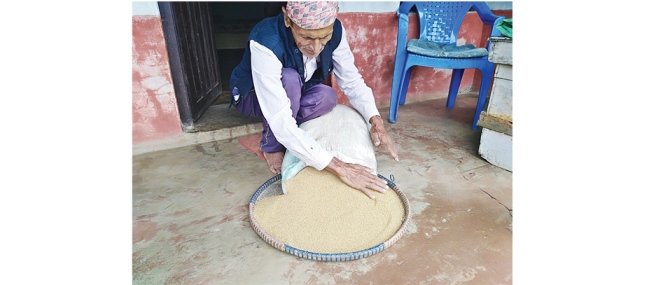Restoring local ‘wild rice’ benefits farmers

By Smita Adhikari
Pokhara, Feb. 23: Monkeys have been giving a hard time to the locals of Kaure Deurali of Rupa Gaunpalika-6, as they frequent the fields destroying and feeding on crops, making it difficult for the locals to save them.
The growing number of monkeys at nearby forest had caused misery for local farmers, munching their way through every crop from maize and wheat to millet to rice.
They have to spend most of the days fending off a barrel of monkeys from invading their crops. This has displaced some villagers and forced many to quit farming for good.
As monkey menace continued to happen in the areas, folks of Gaunpalika have adopted an innovating approach to avoid the loss.
Thanks to the Biodiversity Information Centre (BIC) which motivated the locals to reintroduce the indigenous grains like Kaguno, that don’t attract monkeys at all.
Krishna Prasad Subedi, a local of Rupa Rural Municipality-6, Kaure Deurali seems happy these days because he started growing Kaguno and earning a hefty sum of money.
His family is now free from the year’s long struggle with monkeys to save their crops, said Krishna.
Recalling the past, Krishna said, “There is a forest nearby the field from where monkeys used to come and destroy our crops. Every season we had to stay in the field guarding our crops.”
“Just few years back, all the crops grown in our field got destroyed by monkeys and all our efforts and hard work went up in smoke,” he shared.
Lately, Krishna has started growing Kaguno because monkeys don’t like its taste. He is now making a good money by selling Kaguno, a type of millet, which is also considered as a first domesticated variety of millet.
Krishna exemplifies most of the farmers of Kaure Deurali, who have been earning good money by selling indigenous crops like Kaguno.
They don’t even need to reach the market for selling their crops. The BIC reaches their villages to buy their crops, said Krishna.
According to the BIC, Kaguno is nutritious with a high content of protein, fiber, mineral and non-diabetic and gluten-free.
“Market demands of Kaguno and other wild rice is high because of its health benefits,” said Secretary of BIC Puspa Raj Subedi.
Like Kaure Deurali, BIC has been working to revive the varieties of indigenous rice, like Kaguno, Rato Anadi and Pokhareli Jethobudo in 21 villages of Begnas-Rupa watershed area.
Wild rice is indigenous species of rice grown mostly in many mid-hills and watershed areas of this region. There are a total of 43 types of wild rice grown in the region, every one of them with a distinctive texture, aroma and nutritious values, said Subedi.
But loss of arable land and farmers switching to modern high-
yield hybrids had endangered some of these varieties.
The wild rice like Kaguno, Rato Anadi and Pokhareli Jethobudho can grow easily in wetlands and it doesn’t need hard labour and much investment, said Subedi.
Following the support the BIC, Maina Thapa, 48, of Taalbesi Chaur, Pokhara-31 has recently switched to indigenous rice from modern high-yield hybrids.
This year alone, her family had harvested 80 Muris of Rato Anadi and 150 muris of Pokhreli Jethobudho by cultivating the crops in 50 ropanis of land.
Maina said the demand for both rice grains were very high in the market. To meet the demands of her customers, she had to purchase additional 30 muris of Rato Anadi from the local farmers.
“I’m very thankful to BIC, which helped farmers like me to reintroduce our traditional rice grain and make handsome money,” she added.
Begnas-Rupa watershed area is spread through Begnas Lake and Rupa Lake. Most of the area is covered by hills.
According to the Community Biodiversity Registration (CBR) Programme, total 400 families of this region are reliant on agriculture for their livelihood.
Of them, 60 per cent families have already started growing indigenous rice grains in recent years.
Subedi said the villagers of Siran Swara and Khangi Swara of Kaure Deurali have started cultivating Khaguno rice in almost 100 ropanis of land.
According to Subedi before the programme was introduced in the region, many people were forced to migrate to the cities due to the low return from the farming.
“However, after the BIC introduced the programme and provided technical support, people are more attracted towards agriculture.”
The other reason why people are opting to cultivate indigenous rice crops is that they are earning hefty sum and they don’t have to reach market to sell their products.
The centre itself has been purchasing indigenous rice grains from the local farmers, said Subedi, adding they had been paying Rs. 300 to each pathi of Kaguno and Rs. 5,000 for per muri of Rato Anadi and Pokhareli Jethobudo.
Recent News

Do not make expressions casting dout on election: EC
14 Apr, 2022
CM Bhatta says may New Year 2079 BS inspire positive thinking
14 Apr, 2022
Three new cases, 44 recoveries in 24 hours
14 Apr, 2022
689 climbers of 84 teams so far acquire permits for climbing various peaks this spring season
14 Apr, 2022
How the rising cost of living crisis is impacting Nepal
14 Apr, 2022
US military confirms an interstellar meteor collided with Earth
14 Apr, 2022
Valneva Covid vaccine approved for use in UK
14 Apr, 2022
Chair Prachanda highlights need of unity among Maoist, Communist forces
14 Apr, 2022
Ranbir Kapoor and Alia Bhatt: Bollywood toasts star couple on wedding
14 Apr, 2022
President Bhandari confers decorations (Photo Feature)
14 Apr, 2022











